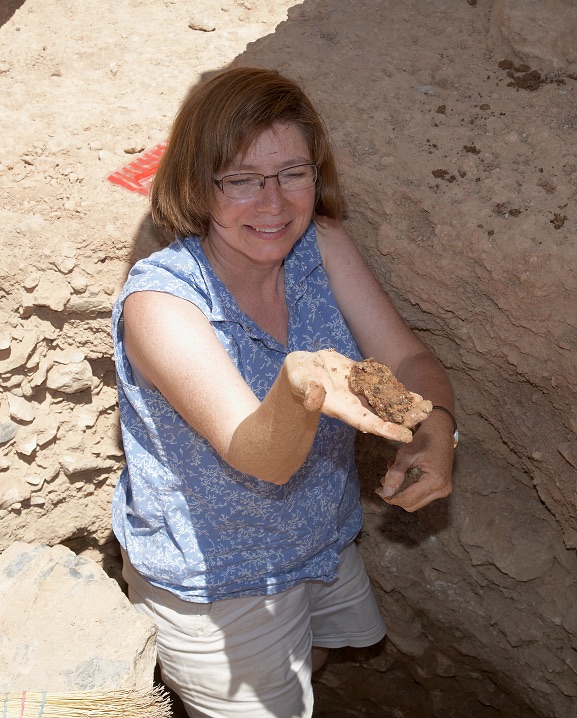Affiliation: University of Waterloo

Professor Maria Liston is with the Anthropology and Classical Departments of the University of Waterloo, and holds her degrees from the University of Tennessee at Knoxville (Ph.D. and B.A.), Indiana University at Bloomington (M.A.) and King College (B.A.). Her areas of specialization are Greek archaeology, skeletal biology and biological anthropology, paleopathology, and military and battlefield archaeology.
The death of one or more infants would have been a nearly universal part of the lives of women in Ancient Greece. Yet until recently, other than a very few burials of women and infants together, there has been almost no evidence for this. Infant remains are rare in cemeteries of nearly all periods. However, the analyses of two wells in the Athenian Agora and Eretria, Euboia provide some of the first evidence for perinatal death and the decisions that were made regarding infant remains. They offer insight into the role of midwives, the interventions that could take place in difficult births, and the causes of infant death. The informal disposal of infant remains in wells also provides some evidence for the process of acquiring a social identity in Greek society. We cannot know how much agency the mothers of these infants had in the decisions made about them, but these infant remains provide unusually detailed evidence for the practice and outcomes of childbirth, a central event in the lives of ancient Greek women.
Short bibliography and/or website on lecture topic:
The Athenian Agora: A short guide in color: www.agathe.gr/Icons/pdfs/AgoraPicBk-16.pdf
Excavations in the Athenian Agora, the Agora Bone Well: Agora Deposit G 5:3 – ASCSA.net
Swiss Excavations at Eretria, Euboia: Eretria – ESAG
The sack of Athens by the Gothic tribe of the Herulians was long thought to be a relatively minor event, until excavations in the Athenian Agora began to reveal evidence of extensive destruction and a dramatic reduction in the size of the city. Since 1931, the American excavations in the Agora have recovered large quantities of destruction debris from wells across the site. Four of these also contained human skeletons in the midst of the destruction debris. Extensive perimortem trauma on the remains reveals the last moments of these victims. On skeleton, an adult male, has other evidence to suggest that he is, in fact, one of the attackers, not an Athenian victim. The study of these skeletons has for the first time allowed us to understand some of the human costs of this attack on the city of Athens.
Short bibliography and/or website on lecture topic:
The Athenian Agora: A short guide in color. www.agathe.gr/Icons/pdfs/AgoraPicBk-16.pdf
The Battle of Chaironeia was a turning point in Greek history. Macedonian forces under the command of Phillip II and his son Alexander defeated a combined Greek force of Athenians, Thebans, and others near the town of Chaironeia, establishing Macedonia dominance over much of the Greek mainland. Anchoring the Greek line on the right was the Theban Sacred Band, an elite military unit consisting of 150 pairs of hoplite soldiers, who were purportedly lovers as well as comrades in arms. Opposite them on the Macedonian left was the cavalry force led by Alexander, then 18 years old. In the course of this decisive defeat of the Greeks, the Theban Sacred Band was almost entirely annihilated. Excavations in the 19th century recovered skeletons of the Theban soldiers interred at a battle monument near the acropolis of Chaironeia. This lecture presents evidence from these skeletons for death on the battlefield and subsequent mutilation of the corpses, and explores the use and efficacy of weapons and armor in ancient warfare.
Short bibliography and/or website on lecture topic:
Plutarch’s Lives, on the Theban Sacred Band: http://www.fordham.edu/halsall/pwh/sacredband.html
The Battle of Chaironeia (Charonea): Battle of Chaeronea – World History Encyclopedia (ancient.eu)
Excavations in the Sanctuary of Ismenion Apollo in Thebes also revealed a later cemetery of Early and Middle Byzantine burials, which are apparently associated with an early Christian hospice or hospital. The skeletons showed that a remarkably high percentage of individuals suffered from significant pathologies with high rates of infectious diseases. Two mass graves are probably associated with the early spread of the Plague of Justinian or a smallpox epidemic. Another epidemic, leprosy, affected nearly everyone in the cemetery, including those who suffered comorbidities such as cancer, brucellosis, and severe trauma. Hospitals serving the whole community were an early innovation of the Byzantine church in Greece, and this project provides a vivid glimpse of the patients whose lives ended there. Thebes also may have been a site of pilgrimage in the early church, drawn by the tomb of St. Luke the Evangelist, located near this cemetery.
Short bibliography and/or website on lecture topic:
History of Leprosy: Eastern Mediterranean | Area | Geographical Region | International Leprosy Association – History of Leprosy (leprosyhistory.org)
The Byzantine Empire Had Hospitals: What Were They Like? | Byzantine Conference (byzconf.org)
Advances in archaeological and analytical techniques can often add new insights into what we know about old finds. An early Iron Age burial in Athens, the tomb of the “Rich Athenian Lady” was extensively studied and published when it was discovered in the 1960’s. However, the study of cremated human remains was in its infancy at that point, and burned remains received little attention. Reexamination of the human bones from this tomb revealed tiny cremated remains of a pre-term fetus, and additional information about the Rich Athenian Lady herself. These discoveries help us to better understand the context of this remarkable burial.
Short bibliography and/or website on lecture topic:
The Athenian Agora: A short guide in color. www.agathe.gr/Icons/pdfs/AgoraPicBk-16.pdf
Early Burials in the Athenian Agora. www.agathe.gr/Icons/pdfs/AgoraPicBk-13.pdf
The Athenian Agora (website) Athenian Agora | American School of Classical Studies at Athens (ascsa.edu.gr)